| Issue 7 |
Climate change has burst into public awareness over the past decade due to a plethora of scientific research, media coverage of severe weather events, and proponents such as Al Gore. Along with a growing number of modern engineering students, my main interest during my undergraduate degree at Oxford was the production of clean renewable energy and how to use it sustainably. While some would argue that there is no definitive proof that global warming is a man-made problem, I would say that the consequences of not acting are far more severe than if the sceptics are right.
In the summer of 2006 I got a stroke of luck while doing some vacation work for Dr Malcolm McCulloch on the electric motors for a Morgan hydrogen-powered sports car. With a little help I managed to persuade my fourth year project supervisor for the next year, Professor Guy Houlsby, to change my project and allow me to work on his idea for a new design of marine tidal turbine, the Transverse Horizontal Axis Water Turbine (THAWT).
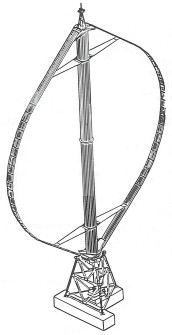
|
| Figure 1: Early Darrieus wind turbine |
THAWT is a conversion of the vertical axis Darrieus wind turbine to a horizontal axis for use in a water stream or channel.
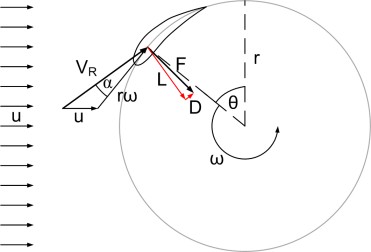
|
| Figure 2: The basic flow mechanics of a Darrieus turbine |
The basic Darrieus turbine design is made up of a number of hydrofoils, which rotate about an axis in an oncoming flow. The combination of the blade's instantaneous velocity and the oncoming flow velocity produces a resultant velocity (VR in Figure 2), which acts at an angle of attack to the blade. This resultant velocity produces a perpendicular lift and a parallel drag. If the angle of attack is greater than the angle subtended by the lift to drag ratio then a positive torque and power will be produced. By using a symmetrical hydrofoil, positive torque can be produced when the angle of attack becomes negative, which means that the turbine rotates in the same direction with flow from either direction. All channels have a velocity profile with slower flow at the base and faster flow at the surface, which should favour one flow direction, but the experimental tests have shown that this has a relatively small effect on the turbine performance.
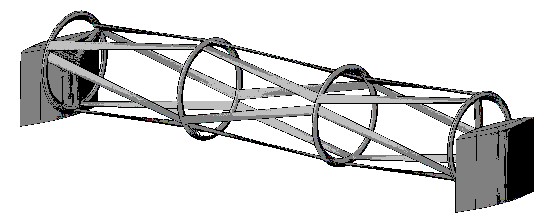
|
| Figure 3: An early concept truss variant of the Transverse Horizontal Axis Water Turbine |
The key feature that Professor Houlsby had conceived was to use the turbine blades as structural members in a truss-like configuration. This would theoretically allow several turbine units to be attached end to end and to benefit from an economy of scale, without compromising the stiffness of the structure.
The turbine had been studied the previous year by two fourth year project students under the supervision of the gas turbine expert, Professor Martin Oldfield. One of the students had managed to extract as mechanical power more than 59% of the kinetic energy in the upstream flow, which is known as the Lanchester-Betz limit and at the time was thought to be the most power that could be extracted from a fluid flow. Whilst it had previously been accepted that tidal turbines extract kinetic energy from fluid flows, Professors Oldfield and Houlsby managed to show that in reality both kinetic and gravitational potential energy are extracted - i.e. the water surface is lower downstream. This meant that in the slow tidal flows commonly found around the world, much more energy is available than was previously thought. Currently all of the turbines that we have tested have spanned the entire width of the flume. If the turbine were used in open water with flow passing around the sides of the device, the proportion of channel area occupied by the turbine would reduce so the height change across the device would decrease along with the proportion of the power extracted.
Continuing from the previous work done in the two fourth year projects of 2005, I designed, built and tested a series of 0.16 m diameter turbines in the third floor flume of the Thom building. The results showed that in some flow conditions the turbine could extract energy up to 3.6 times the kinetic energy in the upstream flow. A finite element model of the turbine was also created which showed that stresses in the truss turbine blades were as much as three times less than the conventional straight bladed design.
With a set of great results, the group applied for a patent for the device and moved towards spinning out a company based on the truss design, in partnership with ISIS Innovation, the University-owned company designed to help spin-outs. In the summer of 2007, as well as generating commercial interest, the academic team began to swell with four DPhil students, an affiliated RCUK fellow and the three senior academics.
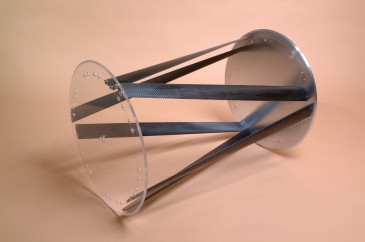
|
| Figure 4: 0.5 m diameter turbine |
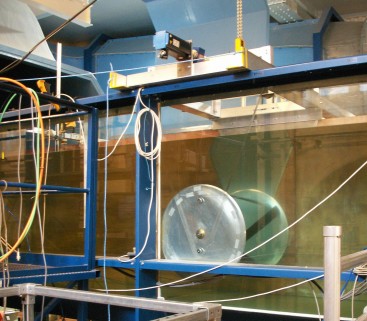
|
| Figure 5: Testing it at Newcastle University |
Having started my DPhil in September 2007, I have continued to develop the design and successfully tested a series of 0.5 m diameter turbines in March 2008 in the combined wind, wave and current tank at Newcastle University. Of all the engineering experiences that I have had at Oxford, this was by far the most difficult and the most valuable in terms of my education. I now understand what it takes to manage an entire project, from the design of the apparatus and testing process to the logistics of obtaining facility time and transporting people and equipment. One of my happiest moments, or perhaps one of my greatest reliefs, was watching the turbine fit perfectly into place in Newcastle having been designed over 200 miles away.
During the tests, the turbine was mounted in an aluminium frame which could be lifted in and out of the flume to allow different configurations of the turbine to be installed quickly. A Perspex endplate allowed videos to be taken of bubbles passing through the turbine to be analysed later using Particle Image Velocimetry. The power from the turbine was brought out of the water using a toothed belt, into a torque and speed sensor and finally into a motor-generator. At certain flow velocities the turbine self-starts but for the lower flow velocities, the motor is used to accelerate the turbine to an angular velocity where it can produce power. In these scale model tests the Reynolds number, a dimensionless value of scale and velocity, was relatively low so the torque produced by the hydrofoils was not as high as anticipated on the full scale device. This can have a severe effect on the turbine performance of smaller-scale devices but can also be taken into account in the numerical modelling of the device.
Despite the low Reynolds number of the flow, the tests proved themselves invaluable as we exceeded the Lanchester-Betz limit with all of our designs, as well as discovering several ways in which the design could be further optimised. Simply watching the turbine operate allowed us to see features in the flow pattern which we had not realised would occur. After taking account of these in our numerical models we were able to increase the accuracy of our power prediction from roughly 60% to over 90%.
With encouraging results as well as a wealth of knowledge about the device, there has been a lot of interest in the project from investors and new research students. The workgroup is now performing consulting for other turbine developers, as well as helping to write standards for the design and application of marine tidal devices. Expect to hear a lot more about the THAWT in the very near future.
| << Previous article | Contents | Next article >> |
| SOUE News Home |
Copyright © 2008 Society of Oxford University Engineers |
SOUE Home |